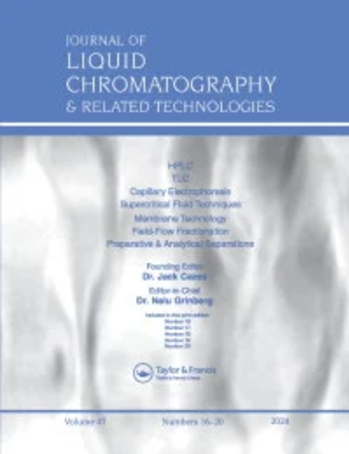基于杂环单体的有机整体柱分析食品、药物和模型混合
IF 1.2
4区 化学
Q4 BIOCHEMICAL RESEARCH METHODS
Journal of Liquid Chromatography & Related Technologies
Pub Date : 2023-07-03
DOI:10.1080/10826076.2023.2235402
引用次数: 0
摘要
摘要本文介绍了用共聚法和后改性法制备整体柱的分离实例。在第一种方法中,由苯乙烯、二乙烯基苯和含氮杂环单体制备了单体。其次,制备了苯乙烯/二乙烯基苯/4-乙烯基氯化苄共聚物,并用1-甲基咪唑进行原位改性。研究表明,整体柱能够分离大分子和低分子化合物。对苯乙烯/二乙烯基苯/1-乙烯基咪唑共聚物柱和ProSwift™RP-3U整体柱进行了比较。建立了基于1-乙烯基咪唑的整体柱,可以分离蛋白质和低分子量的测试物质。然而,ProSwift™RP-3U色谱柱只能分离蛋白质。给出了分离的例子:蛋白质、天然牛奶蛋白、碳水化合物和药物的测试混合物在以苯乙烯/二乙烯基苯为吸附剂的色谱柱上。采用改进柱法测定了乙酰水杨酸制剂中水杨酸的含量。图形抽象本文章由计算机程序翻译,如有差异,请以英文原文为准。
Food, drug and model mix analysis by organic monolithic columns based on heterocyclic monomers
Abstract This paper presents examples of separation on monolithic columns prepared by two different methods: copolymerization and post-modification. In the first method, monoliths were prepared from styrene, divinylbenzene, and heterocyclic nitrogen-containing monomers. In the second, a styrene/divinylbenzene/4-vinylbenzyl chloride copolymer was obtained and in situ modified with 1-methylimidazole. It has been shown that monolithic columns are capable of separating macromolecules and low-molecular compounds. A comparison was made between a styrene/divinylbenzene/1-vinylimidazole copolymer column and a ProSwift™ RP-3U monolithic column. It has been established that a monolithic column based on 1-vinylimidazole is capable of separating proteins and low molecular weight test substances. However, the ProSwift™ RP-3U column is only capable of separating proteins. Separation examples are given: a test mixture of proteins, natural milk proteins, carbohydrates and drugs on a column with a sorbent based on styrene/divinylbenzene. A modified column was used to study the content of salicylic acid in medicinal preparations containing acetylsalicylic acid. Graphical Abstract
求助全文
通过发布文献求助,成功后即可免费获取论文全文。
去求助
来源期刊
CiteScore
2.80
自引率
0.00%
发文量
29
审稿时长
4.9 months
期刊介绍:
The Journal of Liquid Chromatography & Related Technologies is an internationally acclaimed forum for fast publication of critical, peer reviewed manuscripts dealing with analytical, preparative and process scale liquid chromatography and all of its related technologies, including TLC, capillary electrophoresis, capillary electrochromatography, supercritical fluid chromatography and extraction, field-flow technologies, affinity, and much more. New separation methodologies are added when they are developed. Papers dealing with research and development results, as well as critical reviews of important technologies, are published in the Journal.

 求助内容:
求助内容: 应助结果提醒方式:
应助结果提醒方式:


